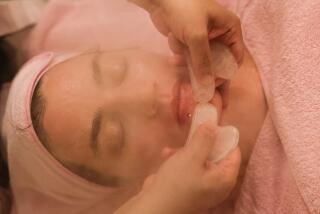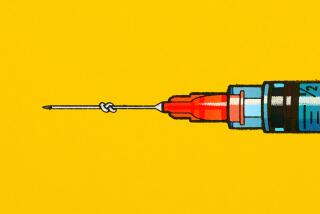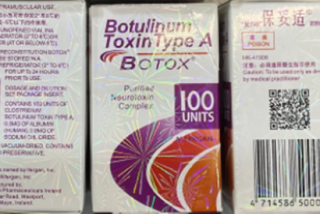Life Etches the Lines, Botox Eases ‘Em
- Share via
It’s the cosmetic equivalent of forbidden love.
Few women will admit to having their wrinkles ironed out with Botox, made from the same toxin that causes the deadly form of food poisoning called botulism. Nevertheless, Botox injections are hot among 30- to 50-year-olds, according to the American Academy of Dermatology in Schaumburg, Ill.
As horrid as it sounds, Botox (the trade name of a diluted, purified form of botulinum toxin A) is approved by the Food and Drug Administration to treat eye twitches and ticks by temporarily paralyzing the muscles responsible. Dermatologists soon began co-opting Botox for use in the same area--on crow’s feet, the vertical “scowl lines” between the brows, and on the horizontal “surprise lines” across the forehead.
By stopping the constant contraction of those muscles (orbicularis oculi, corrugator and frontalis, respectively), which pull on the skin, Botox smooths out expression lines and may even prevent their formation in younger patients. A Botox session can cost anywhere from $325 to $750, depending on the sites treated, and keeps the muscles paralyzed (or “relaxed,” as doctors like to say) for four to six months.
Fans of the treatment say Botox is cheaper than collagen injections and lasts a bit longer, although the two don’t really compete. Botox is used only on the upper half of the face, while collagen works well on the lower, filling in laugh lines and grooves around the mouth. They’re both part of a larger trend toward “wash and wear” procedures that can be done in a doctor’s office on a lunch hour.
Instead of saving up all their money (and their wrinkles) for a $10,000 face lift at age 50, many women are opting for less expensive, noninvasive treatments to fix each new sign of age as it occurs. “People want to improve their appearance without doing something drastic,” says Dr. Howard Murad of the Murad Medical Group in El Segundo. “Botox is part of the broader picture that includes the use of Retin-A, Renova and glycolic acid,” products that soften skin texture and smooth fine wrinkles. Murad has seen a large increase in the number of men and women asking for Botox.
An actor in his 40s sought out Dr. William Binder, a facial plastic surgeon in Los Angeles, at the urging of his TV director boss. The patient’s nervous habit of raising his eyebrows had created deep forehead creases that appeared even deeper on camera. “Collagen wasn’t helping much,” Binder says, “and the patient didn’t want a forehead lift to weaken the muscle. So we tried Botox, which absolutely wiped out those horizontal lines. It was a godsend for his career.”
Vanity is the reason a woman in her 30s sits one recent afternoon in the exam chair in the office of Dr. Joshua Wieder, a UCLA dermatologist who has been injecting Botox for three years. She’s unhappy with the two lines that bulge between her brows whenever she expresses surprise or even interest.
On a surgical tray near the window rests a little black briefcase called the Botox Injection Amplifier, opened to reveal wires, electrodes and a dial that reads “volume.” Also on the tray are long cotton swabs, cotton gauze, rubber gloves and syringes in a plastic case.
The patient has followed the pre-treatment instructions:
* No aspirin or aspirin-like products in the week before the procedure. (They encourage bleeding, which can result in swelling or bruising from the needle sticks.)
* No facials or massages on the same day as Botox, lest the toxin spread outside the treated area.
No one with a neuromuscular disease, such as multiple sclerosis, should receive the treatment. Neither should pregnant (or nursing) women.
Wieder attaches an electrode to the patient’s cheek. The wire runs back to the amplifier and completes the circuit by being attached to the Botox needle. “The needle goes into the muscle,” Wieder says, “and picks up the contraction through the circuit.”
The amplified result sounds like the inside of a seashell. This gizmo allows Wieder to deliver the toxin to the more electrically active portion of the muscle, although not all doctors use it.
“The amplifier is not an absolute necessity,” the doctor explains, “but I think it’s safer because you have auditory recognition that the needle is exactly where you want it to be.” It also may help prevent such possible, but uncommon, side effects as a temporary drooping of the upper eyelid or eyebrow.
“Ready?” he asks the patient. “One, two, three, frown,” he says, and the speakers emit the seashell sound as he injects the Botox directly into the corrugator muscle. “OK, relax,” he says. “Is it burning?” he asks.
“A little,” she says.
Again, he says, “One, two, three, frown” and places the needle in another spot. “Relax,” he says. “Frown again,” he says. “Relax. One more needle stick and then we’re done. OK, now squint. Relax. Squint.”
In goes the toxin, out go the wrinkles. “Relax.”
It’s over in five minutes. Wieder’s assistant swabs the four little red dots with hydrogen peroxide. The patient wonders if she needs Botox on her forehead lines and crow’s feet. Wieder hands her a mirror and asks, “Do you think so?”
They peer at her forehead and the sides of her eyes. “Your skin looks pretty smooth to me,” Wieder says. “But if you want me to inject those areas, I will.”
“No, no, just checking,” she says, glad to be excused. She applies concealer to the puffy pink area between the brows and heads back to the office, where no one will be the wiser.
More to Read
Sign up for Essential California
The most important California stories and recommendations in your inbox every morning.
You may occasionally receive promotional content from the Los Angeles Times.










